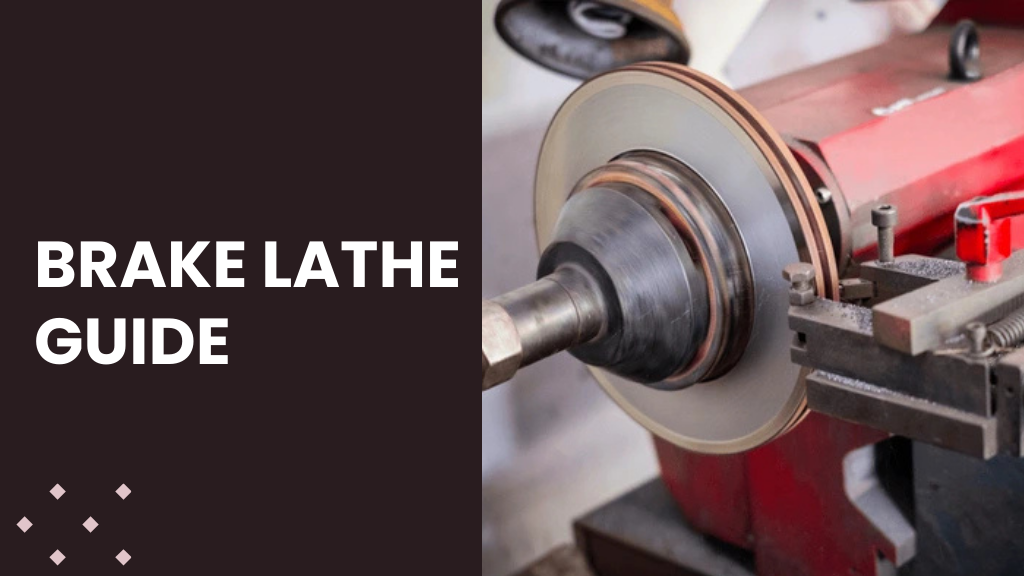Brakes are one of the most important safety systems in any vehicle. Without them functioning properly, the risk of accidents increases dramatically. Over time, brake rotors and drums wear down, creating uneven surfaces that cause vibrations, squealing noises, and reduced stopping power. This is where a brake lathe becomes essential.
A brake lathe is a specialized machine used by mechanics to resurface brake rotors and drums, restoring their smoothness and ensuring proper contact between brake pads and the rotor. Instead of replacing expensive parts, mechanics can use a brake lathe to bring worn components back to life, saving both money and resources.
In this comprehensive guide, we will answer the most common questions including what a brake lathe is, what is the main purpose of a brake lathe, how heavy is a brake lathe, and whether lathes in general have brakes. We will also cover types of brake lathe machines, real-world use cases, advantages and disadvantages, maintenance, history, and future trends.
What Is a Brake Lathe
A brake lathe is a precision machine designed to machine brake rotors or drums by shaving off a thin layer of metal to restore a perfectly flat and smooth surface. This ensures even contact between the brake pad and rotor, which reduces vibration, eliminates squealing, and improves braking performance.
Brake lathes are standard in professional auto repair shops, and they are considered an investment that pays off by extending the lifespan of braking components. Instead of throwing away a rotor that still has usable thickness, the brake lathe makes it like new again.
Key Functions of a Brake Lathe
- Resurfacing brake rotors to eliminate uneven wear
- Restoring brake drums for balanced contact
- Removing grooves, warping, or heat spots
- Improving braking efficiency and safety
- Reducing repair costs for customers
What Is the Main Purpose of a Brake Lathe
The main purpose of a brake lathe is to maintain braking systems so they remain smooth, reliable, and safe. During regular driving, brakes endure extreme heat and pressure. Over time, this stress causes brake rotors and drums to wear unevenly. When that happens, drivers may notice brake pedal pulsation, vibrations in the steering wheel, or unusual noises when slowing down.
A brake lathe solves this issue by machining the surface of the rotor or drum. The process carefully removes a thin layer of metal, making the surface flat and even once again. This not only restores braking performance but also helps prevent premature wear on brake pads, ensuring longer-lasting components.
Benefits of Brake Lathe Usage
- Enhances vehicle safety by allowing smoother, more controlled stops
- Prevents early and uneven brake pad wear
- Saves money compared to replacing rotors entirely
- Reduces vibration, pulsation, and unwanted brake noise
- Extends the overall lifespan of the braking system
Types of Brake Lathe Machines
There are several types of brake lathe machines, each designed with a specific purpose in mind. Choosing the right type depends on the needs of the repair shop, the volume of brake jobs, and whether precision or speed is the priority. Understanding these differences allows mechanics to invest in the right equipment for their workflow.
-
On-Car Brake Lathe
An on-car brake lathe attaches directly to the vehicle’s hub, allowing the rotor to be resurfaced without removal. Since the machining happens while the rotor remains in its natural operating position, alignment is perfect, reducing the chances of runout or misalignment.
Advantages of On-Car Brake Lathes
- Eliminates the need to remove the rotor, saving time
- Ensures accurate resurfacing because it accounts for the vehicle’s hub and bearing alignment
- Reduces labor costs for the shop and turnaround time for customers
- Portable and lightweight compared to off-car models
Best For: Shops that want to perform quick brake services while maintaining high accuracy.
-
Off-Car Brake Lathe
An off-car brake lathe requires the rotor or drum to be removed from the vehicle. The component is then mounted securely on the machine for resurfacing. This method takes more time but allows for higher precision because the component is isolated from other vehicle factors like wheel bearings or suspension alignment.
Advantages of Off-Car Brake Lathes
- Provides exceptional accuracy since the rotor or drum is stabilized
- Ideal for heavily worn or damaged rotors that require more controlled machining
- Can handle larger components that may not be suitable for on-car lathes
- Built for durability and high-volume work
Best For: Professional shops and dealerships that perform frequent brake services and require precision.
-
Combination Brake Lathe
A combination brake lathe is the most versatile option because it can resurface both rotors and drums. Instead of needing two separate machines, mechanics can handle multiple types of brake components with one unit. This versatility makes them a popular choice in repair shops that work on a wide variety of vehicles.
Advantages of Combination Brake Lathes
- Offers flexibility for servicing both brake rotors and drums
- Saves space in the workshop compared to having two separate machines
- Provides long-term value as it adapts to multiple vehicle types
- Often built with heavy-duty construction for reliability
Best For: General repair shops and service centers that want one machine to cover all brake resurfacing needs.
How Heavy Is a Brake Lathe
The weight of a brake lathe depends on the type and model.
- On-car brake lathes are relatively lightweight, usually weighing between 50 and 90 pounds. These are portable and designed for easy use inside a workshop.
- Off-car brake lathes are much heavier, often ranging between 300 and 600 pounds. They are designed for stationary use in a shop setting.
- Combination lathes can be even heavier, typically between 400 and 700 pounds depending on features and construction quality.
The heavy weight of off-car and combination lathes provides stability, which is essential for precision machining. Portable models, on the other hand, sacrifice some stability for mobility.
Do Lathes Have Brakes
Yes, many lathes are equipped with braking systems. Industrial lathes used in metalworking or woodworking typically have spindle brakes that allow the operator to stop the rotation quickly for safety reasons.
In the case of brake lathes, safety mechanisms are built in to stop the rotation instantly when necessary. This protects both the operator and the brake component being machined.
History of Brake Lathes
The concept of resurfacing rotors rather than replacing them emerged as cars became more common in the mid-20th century. Originally, rotors were thicker and designed to last longer, so resurfacing was a practical solution.
Companies like Ammco and Hunter became pioneers in developing brake lathe technology. Over time, as rotors became thinner and vehicles more advanced, brake lathe machines also evolved to offer better precision and efficiency.
Real-World Example of Brake Lathe Use
Consider a vehicle that comes into a repair shop with severe brake vibrations. Instead of replacing the rotors, which may cost 200 to 400 dollars per axle, the mechanic uses a brake lathe to resurface them. This process costs the customer around 50 to 100 dollars per rotor, providing significant savings.
For the shop, owning a brake lathe also means better service offerings and higher customer trust. Many customers prefer resurfacing because it is cost-effective and environmentally friendly.
Brake Lathe vs Rotor Replacement
While a brake lathe can restore worn rotors, there are cases where replacement is unavoidable.
When to Use a Brake Lathe
- Rotor thickness is above the manufacturer’s minimum specification
- Surface imperfections are not too deep
- Customer prefers cost-effective repairs
When to Replace Rotors
- Rotor thickness is below minimum safety standards
- Deep cracks, severe grooves, or rust are present
- Excessive warping or overheating damage
A skilled mechanic will measure the rotor with a micrometer before deciding whether resurfacing or replacement is the best option.
Advantages of Brake Lathes
Brake lathes offer numerous benefits for both mechanics and vehicle owners. By resurfacing brake rotors and drums instead of replacing them, they provide a cost-effective, efficient, and environmentally friendly solution.
-
Cost Savings for Customers and Shops
One of the biggest advantages of brake lathes is the potential for significant cost savings. Instead of purchasing new rotors or drums, resurfacing allows the component to be reused safely. This not only reduces expenses for the customer but also enables repair shops to offer affordable service options, increasing customer satisfaction and loyalty.
-
Extends Rotor and Drum Life
Brake lathes extend the lifespan of rotors and drums by restoring a smooth, even surface. Proper resurfacing prevents uneven wear and reduces the chances of warping or cracking over time. By maintaining the integrity of the original component, brake lathes allow vehicles to remain on the road longer without unnecessary part replacements.
-
Improves Braking Safety and Performance
A resurfaced rotor or drum ensures consistent contact between the brake pads and the braking surface. This improves overall braking performance, eliminates vibrations, and reduces pedal pulsation. Smoother braking enhances vehicle safety by ensuring predictable stopping distances in various driving conditions.
-
Versatility Across Different Models
Brake lathes come in various types, including on-car, off-car, and combination machines. This versatility allows mechanics to work on a wide range of vehicles and components, adapting to the needs of different repair tasks. Whether machining a rotor still on the car or working with removed components, brake lathes provide flexibility in daily shop operations.
-
Environmentally Friendly Option
By resurfacing rather than replacing rotors, brake lathes contribute to reducing waste. Fewer discarded metal components mean less environmental impact and a smaller carbon footprint for auto repair operations. Shops that promote resurfacing can also appeal to environmentally conscious customers.
Disadvantages of Brake Lathes
While brake lathes offer many advantages, there are some limitations and challenges that mechanics and shop owners should be aware of. Understanding these disadvantages helps in making informed decisions about when to use a brake lathe versus replacing components.
-
Cannot Be Used on Extremely Thin Rotors
One of the primary limitations of brake lathes is that they cannot resurface rotors or drums that have worn below the manufacturer’s minimum thickness specification. Attempting to machine a rotor that is too thin can compromise safety, reduce braking efficiency, and even cause component failure. In such cases, replacement is the only safe option.
-
Requires Skilled Operation
Operating a brake lathe effectively requires proper training and experience. Incorrect setup, alignment, or machining technique can result in uneven surfaces, over-machining, or damage to the rotor or drum. Shops must ensure their technicians are well-trained to maximize the benefits of the machine and maintain high-quality results.
-
Heavy Off-Car Models Occupy Workshop Space
Off-car and combination brake lathes are large and heavy, sometimes weighing several hundred pounds. This makes them stationary machines that require significant space in a workshop. Smaller garages or mobile repair services may find it challenging to accommodate such equipment, limiting their ability to perform off-car resurfacing.
-
Modern Vehicles May Favor Replacement
With advancements in vehicle design, many modern cars use rotors that are thin and inexpensive. In some cases, the cost and effort of resurfacing may exceed the cost of simply replacing the rotor. Additionally, certain high-performance or specialty rotors may be designed to be replaced rather than resurfaced, reducing the applicability of brake lathes.
Maintenance of Brake Lathe Machines
Like any precision equipment, brake lathes require regular maintenance to operate effectively.
- Keep the machine clean and free of debris
- Regularly inspect cutting tools and replace when dull
- Lubricate moving parts to reduce wear
- Calibrate the machine for accurate resurfacing
- Store portable lathes properly to avoid damage
- Proper care ensures consistent results and extends the life of the machine.
Cost of Brake Lathe Machines
The price of a brake lathe depends on the type and brand.
- On-car lathes typically cost between 3,000 and 5,000 dollars
- Off-car lathes can range from 5,000 to 10,000 dollars or more
- Combination lathes are in the 6,000 to 12,000 dollar range
While the initial cost is high, the return on investment for an auto repair shop is significant because brake services are one of the most common repair jobs.
Future of Brake Lathe Technology
As electric vehicles and modern braking systems evolve, brake lathe machines are also adapting. Many EVs use regenerative braking, which reduces wear on rotors. However, brake rotors can still rust or develop uneven surfaces from infrequent use, making resurfacing relevant.
Future brake lathe machines are likely to be more automated, precise, and compact. Integration with digital diagnostics may also become standard, allowing mechanics to measure and resurface in one step.
Conclusion
A brake lathe is one of the most valuable machines in any auto repair shop. By resurfacing rotors and drums, it restores braking performance, improves safety, and saves customers money compared to replacement. Whether you are considering an on-car, off-car, or combination brake lathe, understanding its purpose, weight, and function will help you make the right decision.
With proper maintenance and skilled operation, a brake lathe can serve as a long-term investment for mechanics and shop owners. As vehicles continue to advance, brake lathe machines will remain a crucial part of keeping cars safe on the road.
FAQs
What is a brake lathe used for
A brake lathe is used to restore smooth surfaces on brake rotors and drums, eliminating imperfections that cause vibration, noise, and reduced braking performance.
What is the main purpose of a brake lathe
The main purpose is to ensure braking systems are safe and effective by providing smooth and even rotor and drum surfaces.
How heavy is a brake lathe
On-car lathes are lightweight at 50 to 90 pounds, while off-car and combination lathes can weigh anywhere from 300 to 700 pounds.
Do lathes have brakes
Yes, many lathes including brake lathes are equipped with braking systems for operator safety and precision control.
Is it better to resurface or replace rotors
Resurfacing is cost-effective if the rotor is still within thickness specifications. Replacement is necessary if the rotor is too worn or damaged.




